Hugh Brown: A Pioneer’s Story
The following story was published in the Carrum Borough Gazette on August 10, 1923. The author was not acknowledged.
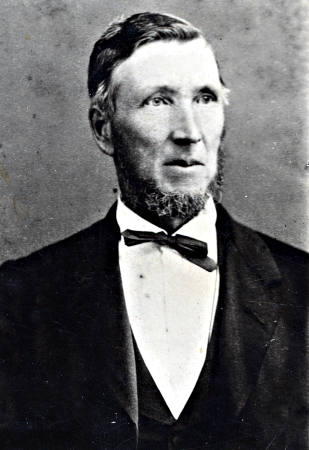
Hugh Brown, Pioneer. Courtesy Chelsea and District Historical Society.
A most interesting interview, and one of some importance to the districts from Frankston to Mentone, occurred on Wednesday last, when our representative met Mr Hugh Brown at “Pine Vale,” Mordialloc. Mr Brown who looked exceptionally well and alert for his great age of 93 years last March, seemed exceptionally gratified in meeting our representative, and seemed impressed with the importance of having a record kept of the important information he had at his disposal. In fact, he assured our scribe that no other person was in the same position as regards the knowledge of certain events which in all probabilities may be of service to municipalities as a record.
Mr Brown came to the district on April 16, 1856 and resided in what is now known as Parkdale. He having arrived in Adelaide on of August 12,1855, from the North of Ireland. The districts then were divided into “runs”. The “run” from the Kananook creek at Frankston to the Mordialloc creek belonging to a Mr McMahon. On the other side, next to Frankston, the run belonged to two brothers named Wedge, who afterwards left the district, and Mr Beilby came into possession, taking up the “run.” Next to them was a “run” owned by the Keys brothers, and on the other side of the swamp was Mr McDonald, the latter “running” to Mordialloc. Later on the Government took these “runs” away, and surveyed for allotment, first that portion between the main road the beach, besides about half-a-dozen lots on the other side of the road (then about 3 chains wide). A pre-emptive right was given to the previous occupiers, in virtue of them having held the right of the “runs”. The lots on the other side of the road were at the end nearest Mordialloc, it being high and dry land, next to the aborigine reserve now the Attenborough park, on portion of which Mr Brown now resides. He took up these lots, and required more land, but finding he was unable to acquire the lots next to his, he then applied for a lot not then surveyed.
Mr Callanan, a surveyor, with party was sent down, and camping under a tree on Mr Brown’s property, they, under direction of the Government, surveyed the whole of the Carrum swamp, throwing it open for selection. Mr Brown selected a property next to his own, of 44 ½ acres in extent. It is noteworthy that before the Government survey, the Carrum swamp was used as a farmers’ common, the managers of the common being Mr John Potts, of Moorabbin, Mr John Keys, of Keysborough and Mr Howard, of Frankston.
Mr McMann was the first person appointed as caretaker, his duties being to take charge of cattle brought to him by the farmers; look after them, and deliver them to the owners when they required them. The charge was 3/- per head of cattle per year.
Just about this period, Mr Lochard Morten petitioned the Government for a grant of 10,000 acres for grazing purposes. The Government, however, refused the request. Some time later Nathaniel Levy made application for the Carrum swamp, producing a scheme for the drainage of it, with the intention , as he said, of growing sugar beet. The Government again refused, and had it surveyed and thrown open for selection, reserving about 400 acres for Mr Levy, but he refused to take so small a quantity. This area was then surveyed and sold the purchaser being a retired English judge, named Elliott, who afterwards sold to Mr Bradshaw, who turned it into a racecourse, calling it the Richford racecourse, but it was afterwards re-sold to a Mr James, and used for farming purposes. After the Government survey, the whole of the swamp was thrown open for selection, and sold on condition that besides paying for the acreage, each selector had to pay in addition to the price of land to the Government, a surcharge of 3/- per acre to the shire council for drainage purposes. The shire council in addition contributed £500 towards the drainage. The scheme was carried out as far as the money went, but finding that it was no better a number of the occupiers, including Mr Brown, presented a petition to the Government asking for £28,000 to provide a scheme to drain the whole Carrum swamp. This petition, which was signed by 36 different occupiers, together with the acreages of properties owned, was drawn up and signatures obtained by Mr John Keys, Mr Hugh Brown, Mr Geo Alwyn, and Mr Edwin Nicholls, each of whom made the necessary declaration. The petition was forwarded to the Government and they agreed to grant the money, and formed a commission of which Mr H Brown was a member, with power to carry the scheme into effect. After the Commissioners were appointed, tenders were called for an engineer to carry out work, and from a large number of applicants Mr Michael Elliot was appointed. The scheme, which was carried out, proved to be not altogether successful, and application was made again to the Government, through Mr J Keys, M.L.A., for a grant to enable the Dandenong shire council to cut a drain through at Carrum. The money obtained, the council carried a channel through 25 feet wide, and built a bridge across it at Carrum on the main road, at what is now known as the Patterson river, named as such on account of Mr Patterson granting the necessary money, he being, at the time, the responsible Minister. The swamp was subjected to floods each year, some of them being of exceptional character, and the next big flood carried the bridge away, and widened the channel considerably. A second bridge was built, but the heavy floods of about 1890 were responsible for washing this bridge away, and again widening the channel.
At this juncture, Mr Brown related two incidents which have some bearing on the matter. Shortly after the first channel was cut, and the bridge built, the bridge seemed so small that people called it “Patterson’s Folly,” and an editor, Mr Alexander, who owned a small Brighton paper, hearing it called “Patterson’s Folly” went to Mr Brown to get particulars, as he wished through the columns of his paper to expose it, and incidentally, the Minister. Mr Brown said: “I took Mr Alexander up through the whole swamp and explained to him, showing him the whole scheme, both in reference to the drainage, the channel and the bridge. He went away quite satisfied that the whole was a great success, and “Patterson’s Folly” became “Patterson’s River.” Mr Brown considered that but for the Patterson drain, the townships along the foreshore would never have existed, as the whole of the swamp would have been uninhabitable, remaining only as farming land, subjected to floods every year. The other incident recalled was the flood which carried away the second bridge, which he said “he would never forget.” A man called on him , having travelled from Frankston way, and remarked to Mr Brown: “There will sure to be loss of life on that bridge before morning, if someone does not attend to it.” Mr Brown, knowing a fisherman living at Carrum, went there and begged him to watch the bridge all night. On the following morning he went to see him. A part of the bridge had gone, and the roaring of the water prevented him from being heard across the stream. Thinking that as the part of the bridge on the Mordialloc side had not been washed away, that it would in all probability remain standing, and in order to be heard he went to the end of the part remaining, and whilst standing there conversing, his friend threw up his hands as a danger signal. Mr Brown had scarcely time to recover the roadway when the whole bridge was washed away before his eyes. After the second bridge was washed away it was necessary to get three large punts, placed end to end across the stream, upon which a roadway was made to Frankston, and served until the present bridge was built in 1891. Since the large bridge was erected the floods having widened the channel to its present width, the floods which have since occurred having been minor, no very perceptible damage has been done.
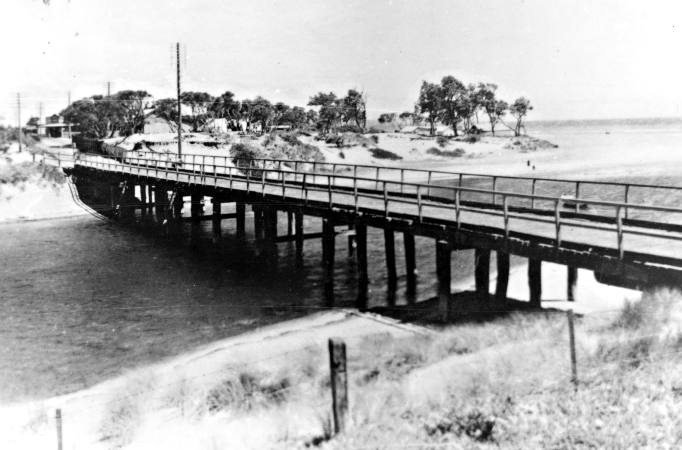
Bridge over the Patterson River, 1891–1927. Courtesy Chelsea and District Historical Society.
On being questioned as to the main road, Mr Brown said that when he first arrived in the district the road was in such a state, being nothing but a sand track, that it was as much as a man could do to take an empty cart from Mordialloc to Frankston and that if he went there and back he would not try it again. He said that at two mile scrub, now Aspendale, that in driving cattle to and fro that hundreds of cattle were lost, by wandering into the ti-tree, it being impossible to recover them; a big percentage of them being lost would wander down into the swamp and never be seen again. Hundreds also were captured and sold at a later date, as they were wandering about, no one owning them.
The Government first made portion of the road at the Frankston end, and afterwards continued it on to Mordialloc, doing the work themselves, and employing labour. It was then “No Man’s Land,” and there was no rates or payments levied. There was then no council; what afterwards became the Dandenong shire council was only a roads board, as was also the case at Moorabbin.
When Carrum swamp was thrown open and taken up for selection, then the Dandenong shire council was formed and took over the Carrum swamp for rating purposes, the shire being formed, and the Carrum swamp becoming the south riding.
Mr Brown was questioned about the railway, and he seemed to treat the matter as a decided modern innovation, and remembered the railway being continued through to Frankston, as quite a recent event.
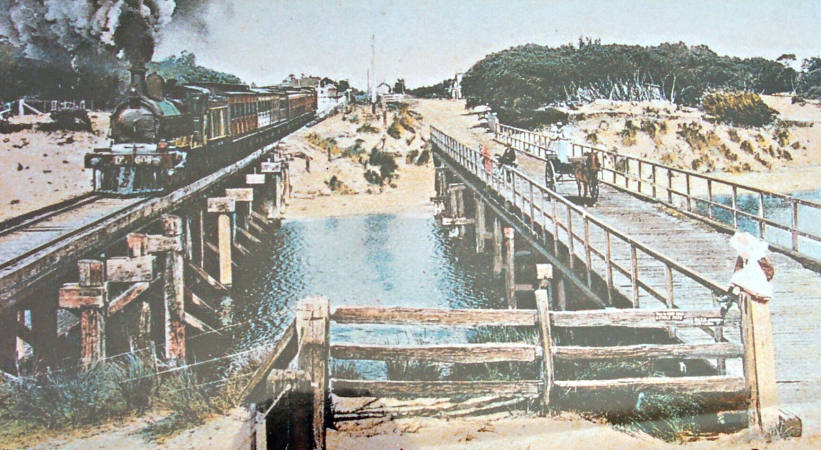
Train crossing the Patterson River, c1890. Courtesy Chelsea and District Historical Society.
When Mr Brown came here there were no railways. The first line, the Hobson Bay line, was from Melbourne to St Kilda beach, and from thence to St Kilda junction, through the swamp being carried through on a high bank with poles down into the swamp. This was taken away, and a railway was built from Melbourne to South Yarra, and from there on to Brighton. Afterwards the railway was build from South Yarra, in Tommy Bent’s time, to East Brighton (now Bentleigh), named after Mr Bent, and then on to South Brighton (now called Moorabbin). These two names were altered on account of the confusion in the two lines, people continually getting on the wrong line.
Later the line was continued on through Cheltenham to Mordialloc. When the movement was first mooted to carry the line through to Frankston, the first survey was through Mr Brown’s property, across the swamp to Seaford. This would have caused a considerable depreciation of the properties through which it would have been cut, according to Mr Brown’s version, as it would have taken people away from the beach; visitors would have had to climb up a steep incline before being able to get to the beach, whereas now they are in close proximity to the beach, and the properties are not cut through. The difficulty of securing a railway was met by the people of the district, allowing the Railway Department to use the centre of the three chain road. The engineer, Mr Madden, was sent down to do the necessary engineering survey. The railway was first secured as far as Aspendale for the racecourse, and when obtained the people pushed for its continuance to Frankston.
Mr Brown was next questioned as to existing houses. He stated that the first house he resided at was on the Balcombe road, near the beach, and between his house and Mordialloc was only one other residence. At Mordialloc was the hotel and two huts, named “Grannies’s” and “Macdonald’s” McDonald had the pre-emptive rights of what is now the State settlement, and also the pre-emptive rights of the hotel. Between Mordialloc and Frankston was the half-way house, now the Riverina hotel, at Carrum. The pre-emptive rights of which was owned by a Mr McMann, who resided at the hotel.
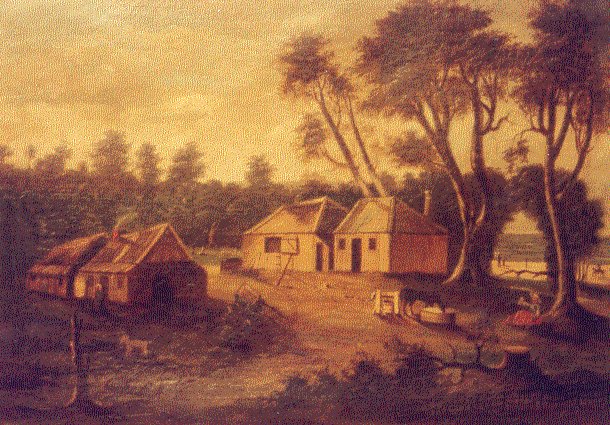
Macdonald Homestead, Mordialloc. Courtesy Kingston Collection.
Mr Brown, amongst the reminiscences of the time, said that in going to different places, such as for instance when he had to go to Oakleigh to see after some cattle, the use of the compass was necessary to locate your destination, or locality. The roads were surveyed, but not made, and were in places dense scrub.
When asked if the blacks were here, he answered with emphasis: “The blacks here; I should just think they were. Why there was old King Macdermid, the king of the blacks, who was so fond of Mrs Brown that he would not let them take him away to Melbourne hospital, before he came and said good-bye to her. He is supposed to have died in Melbourne hospital shortly after, and although there was a rumour that he was sent away, still I believe that he died there in the hospital.
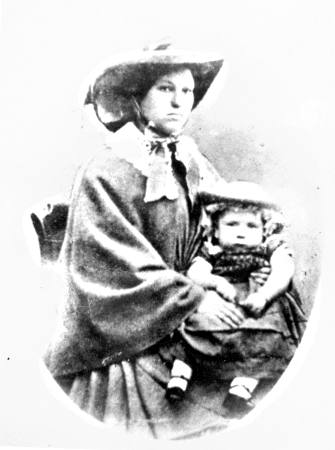
Mrs Brown and child, c1900. Courtesy Chelsea and District Historical Society.
Were the blacks sent from here? He was asked. “Oh, no; they all died. Mr McDonald used to supply them with rations, and the Gippsland blacks used to come down and camp on the reserve once a year for their supply of rations and blankets, which McDonald used to issue to them. Their camp was situated on that part where the Mordialloc school is now built. There was one of the resident blacks who was a very intelligent fellow and used to do a little of the work about the farm.” Mr Brown also said that he has often watched them out with their dogs ‘possum hunting, and at one time he had to wade out up to his waist in water to drive some of the dogs off his calves, and to rescue them, and foolish like went on working in his wet clothes and got an acute attack of sciatica, that he could scarcely move for some time.
Mr Brown had them fishing and eel spearing and explained their method of catching eels. He said they would sell their catch, and would take nothing less than threepence, saying they wanted “blackman’s money.”
Mr Brown has letters, books and charts and other plans which give many more details concerning the development of the foreshore townships, and showed our representative some very interesting ones, to explain matters as he went along, and time alone deterred him from obtaining still further particulars. An interesting letter he was shown from Mr Michael Elliot, who wrote from New Zealand in answer to a letter from Mr Brown, asking for levels and giving details of a culvert at Mordialloc creek that was causing trouble by keeping back the flood waters and pointing out the remedy.
Mr Elliot who was related to Mr James Balfour, at one time a member of Parliament, was the engineer selected when the drainage scheme of Carrum swamp was carried out, and Mr Brown said he had been on the relief expeditation sent to the relief of Gordon at Omdurman, he being on the work connected with the drainage of a swamp.
